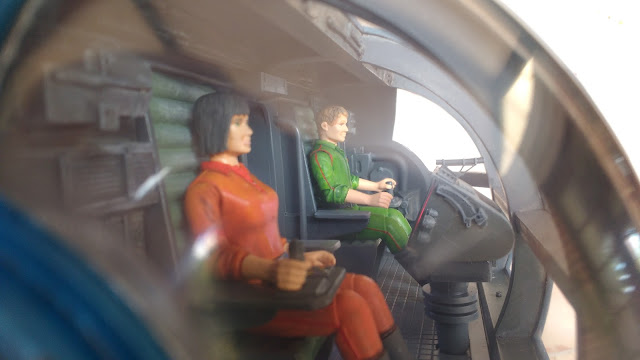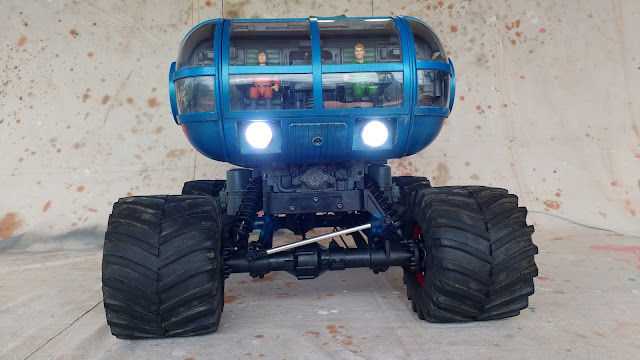Note: Google informed me today that they deleted my original "Moon Bug part 7 completed" post as it didn't meet their guidelines, something about malware and viruses. I have no idea what they are talking about and there seems to be no way to ask exactly what was the problem. If there was any malware or a virus it certainly wasn't put there by me. I find it really irritating that without any warning they just delete something that I put a lot of effort into and then don't have a mechanism for any helpful discussion. How am I supposed to prevent this happening again if I have no understanding of why it happened in the first place?
So now I have to re-create the post, luckily I also post on the RPF so I have a record of the original text.
Last time the model was at the primer stage, so the first job was to
devise a paint scheme. As is my process these days I took a grey primer
photo into photoshop and fiddled about until I came up with something I
liked. As the vehicle has a whimsical comic book outline I wanted to do a
colorful paint job to go with it. This is what I came up with.
I then decided to design up and make some decals to add to the graphic
nature of the finish. These I designed in Inkscape which is a free open
source vector graphic editing program. I have always liked the graphic
elements that Chriss Foss would apply to his gouache painted spacecraft
book covers of the 1970s'. Referring to my Chriss Foss art book I
availed myself of some of his genius and some of the decals do bear a
very strong resemblance to his work. Here is the decal sheet.
One of the problems with DIY decals is that inkjet printers can't print
white so if you want white in your decal you have to use white decal
paper. That then means the carrier is white and you have to carefully
cut around each decal to remove the extraneous white around the edges.
Of course you can use clear decal paper which means you don't have to be
as precise when cutting out the decal as the borders will be clear and
will not be visible once applied but any white areas on your design will
come out clear. If it is a big decal you can paint a white area where
you want the white bit to be but for small decals I think it would be
too hard to get the white painted areas that accurate.
I printed onto white decal paper and once cutting out the decals and
applying them with much setting solution found that little white edges
showed up which wasn't exactly what I wanted. I have since found some
online tips for using white decal paper, where the edges of the decal
should be coloured with a permanent marker to get rid of any white bleed
once applied. Too late for me but a good idea for any future project
that needs custom decals.
Paint was car paint from touch up spray cans with varying shades mixed
up once decanted into airbrush jars and airbrushed on. Weathering was my
usual method of a wash of Tamiya flat back diluted in much methylated
spirits, wiped off with a metho soaked rag in the direction of the
required streaks and drybrushing with white students acrylic. I then
also added some oil paint colour modulation and a dirty brown pin wash.
One of the things I tried out on this model was painted panels lined out
with a fine permanent marker pen. Models from Terrahawks recently came
up for auction with accompanying photos and they had a surface that used
a similar technique to very good effect.
My conclusion is that I prefer to have panels that are in the very least
scribed into the surface if not actually separate from the underlying
surface and glued on individually. I prefer the way light hits an actual
edge with both a highlight on one side and a shadow on the other.
One thing I added to the model was a couple of dummy whip aerials on the
top blisters at the rear. They are made from bicycle gear cable with a
couple of plastic kits parts for a mount and a termination at the top.
They should wave about fairly realistically when the vehicle is in
motion.
Finally here is the finished model.
Thanks for looking...
More soon...




























No comments:
Post a Comment